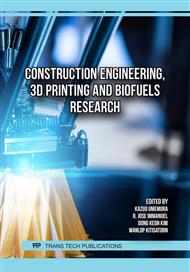[1]
Rajendra Hamad,Subir Kumar, Chakraborty (2023). Understanding the changes in millable oil content and fatty acid composition of infrared radiation treated mustard (Brassica juncea) seeds using Vis-NIR-SWIR hyperspectral imaging Infrared Physics & Technology 10 October 2023.
DOI: 10.1016/j.infrared.2024.105128
Google Scholar
[2]
Thu Nguyen,Ruchira Nandasiri (2023). Optimization of pH for extracting sinapates from mustard varieties using green technology, Applied Food Research26 July 2023.
DOI: 10.1016/j.afres.2023.100323
Google Scholar
[3]
Inna Popova,Dev Shrestha,Matthew Morra (2023) Pilot-scale extraction of multiple biopesticidal compounds from mustard biofuel by-products, Industrial Crops and Products25 April 2023.
DOI: 10.1016/j.indcrop.2023.116775
Google Scholar
[4]
Volkan Aslan (2023) Fuel characterization, engine performance characteristics and emissions analysis of different mustard seed biodiesel: An overview, Journal of Biotechnology19 May 2023.
DOI: 10.1016/j.jbiotec.2023.05.006
Google Scholar
[5]
Shahabaldin Rezania, Saeideh Mahdinia ( 2021) Biodiesel production from wild mustard (Sinapis Arvensis) seed oil using a novel heterogeneous catalyst of LaTiO3 nanoparticles
DOI: 10.1016/j.fuel.2021.121759
Google Scholar
[6]
Sarthak Baweja,Ajay Trehan,Rajan Kumar (2021) Combustion, performance, and emission analysis of a CI engine fueled with mustard oil biodiesel blended in diesel fuel, Fuel11 February 2021.
DOI: 10.1016/j.fuel.2021.120346
Google Scholar
[7]
Ahmet Uyumaz (2018), Combustion, performance and emission characteristics of a DI diesel engine fueled with mustard oil biodiesel fuel blends at different engine loads, Fuel15 January 2018.
DOI: 10.1016/j.fuel.2017.09.005
Google Scholar
[8]
Sarthak Baweja,Ajay Trehan,Rajan Kumar (2021) Combustion, performance, and emission analysis of a CI engine fueled with mustard oil biodiesel blended in diesel fuel, Fuel11 February 2021.
DOI: 10.1016/j.fuel.2021.120346
Google Scholar
[9]
Ahmet Uyumaz (2018), Combustion, performance and emission characteristics of a DI diesel engine fueled with mustard oil biodiesel fuel blends at different engine loads, Fuel15
DOI: 10.1016/j.fuel.2017.09.005
Google Scholar
[10]
Arvind Kumar Madheshiya, Ajitanshu Vedrtnam , Energy-exergy analysis of biodiesel fuels produced from waste cooking oil and mustard oil, Fuel Volume 214, 15 February 2018, Pages 386-408. January 2018.
DOI: 10.1016/j.fuel.2017.11.060
Google Scholar
[11]
P.A. Satyanarayana a, Ravi Kanth Oleti b, Swarna Uppalapati c, V. Sridevi d, Characterization of Used Cooking Oil and Mustard Oil for Biodiesel Production: Engine Performance, Volume 5, Issue 9, Part 3, 2018, Pages 18187-18201
DOI: 10.1016/j.matpr.2018.06.155
Google Scholar
[12]
Thokchom Subhaschandra Singh a, Tikendra Nath Verma b, Case study of nonrefined mustard oil for possible biodiesel extraction: feasibility analysis, Advanced Technology for the Conversion of Waste into Fuels and ChemicalsVolume 1: Biological Processes 2021, Pages 315-336
DOI: 10.1016/b978-0-12-823139-5.00016-2
Google Scholar
[13]
Arvind Kumar Madheshiya, Ajitanshu Vedrtnam , Energy-exergy analysis of biodiesel fuels produced from waste cooking oil and mustard oil, Fuel Volume 214, 15 February 2018, Pages 386-408.
DOI: 10.1016/j.fuel.2017.11.060
Google Scholar



